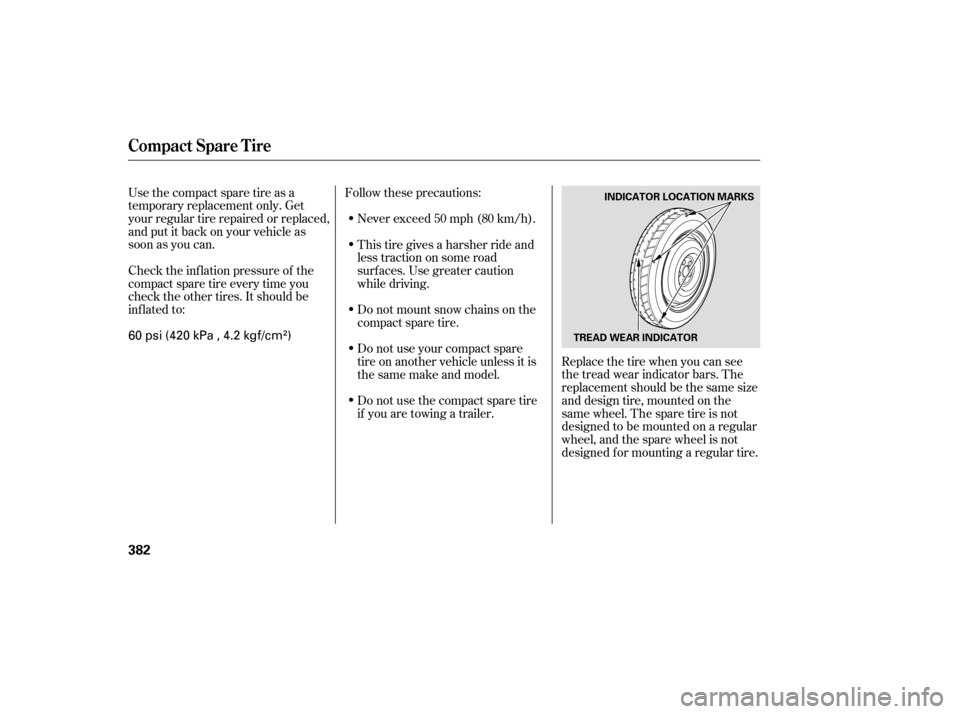Page 325 of 442
The lights and brakes on your
vehicle and the trailer are working
properly.
When preparing to tow, and bef ore
driving away, be sure to check the
f ollowing: The trailer has been properly
serviced and is in good condition.
All weights and loads are within
limits.
Thehitch,safetychains,andany
other attachments are secure.
All items in or on the trailer are
properly secured and cannot shif t
while you drive.Your vehicle tires and spare are
properly inf lated, and the trailer
tires and spare are inflated as
recommended by the trailer
maker.
You may want to fill the fuel tank
with premium f uel. Premium f uel
provides improved perf ormance.
The vehicle has been properly
serviced, and the suspension,
cooling system, and lights are in
good operating condition.
Pre-T ow Checklist
Towing a Trailer
Driving
321
�����—�����—�
���y�
�������������y���
�(�)� �������y���������y
Page 326 of 442

When climbing hills, closely watch
your temperature gauge (see pages
and ). If it nears the H (Hot)
mark, turn the A/C of f , reduce
speed and, if necessary, pull to the
side of the road to let the engine cool.
When driving down hills, reduce
your speed, and shif t down to S
position, or use the puddle shif t to
the lower gear (3, 2 or 1)in the S
position. When towing a trailer, do
not ‘‘ride’’ the brakes, and remember,
it will take longer to slow down and
stop when towing a trailer.
Drive slower than normal in all
driving situations, and obey posted
speed limits f or vehicles with trailers.
Use the D position when towing a
trailer on level roads. See ‘‘
’’ in the next column f or
additional gear inf ormation. Do not
exceed 55 mph (88 km/h). At higher
speeds, the trailer may sway or
af f ect vehicle handling.
Make turns more slowly and wider
than normal. The trailer tracks a
smaller arc than your vehicle, and it
canhitorrunoversomethingthe
vehicle misses. Allow more time and
distance f or braking. Do not brake or
turn suddenly as this could cause the
trailer to jackknif e or turn over.
The added weight, length, and
height of a trailer will af f ect your
vehicle’s handling and perf ormance,
so driving with a trailer requires
some special driving skills and
techniques.
Foryoursafetyandthesafetyof
others,taketimetopracticedriving
maneuvers bef ore heading f or the
open road, and f ollow the guidelines
in this section.
8378
Driving on Hills
T owing Speeds and Gears
Driving on
Hills
Making T urns and BrakingDriving Saf ely With a T railer
Towing a Trailer
322
�����—�����—�
���y�
���������
���y���
�(�)� �������y���������y
Page 327 of 442

If you must stop when f acing uphill,
use the f oot brake or parking brake.
Do not try to hold the vehicle in
placebypressingontheaccelerator,
as this can cause the automatic
transmission to overheat.Crosswinds and air turbulence
caused by passing trucks can disrupt
your steering and cause the trailer to
sway. When being passed by a large
vehicle, keep a constant speed, and
steer straight ahead. Do not try to
make quick steering or braking
corrections.
Always drive slowly and have
someone guide you when backing up.
Grip the of the steering
wheel; then turn the wheel to the lef t
to get the trailer to move to the lef t,
andturnthewheelrighttomovethe
trailer to the right.Follow all normal precautions when
parking, including putting the
transmission in Park and f irmly
setting the parking brake. Also, place
wheel chocks at each of the trailer’s
tires.
bottom
Handling Crosswinds and Buf f et ing
Backing Up Parking
Towing a Trailer
Driving
323
�����—�����—�
���y�
���������
���y���
�(�)� �������y���������y
Page 347 of 442

�Î
�Î
�Ì �Ì
�Ì
�Î
Maintenance Minder
343
: Maintenance
Main Items
Replace engine oil
Replace engine oil and oil filter
Inspect front and rear brakes
Check parking brake adjustment
Inspect these items:
Tie rod ends, steering gear box, and boots
Suspension components
Driveshaft boots
Brake hoses and lines (including ABS)
All fluid levels and condition of fluids
Exhaust system
Fuel lines and connect ions Maintenance
Sub Items
Rotate tires
Replace air cleaner element
If you drive in dusty conditions, replace
every 15,000 miles (24,000 km).
Replace dust and pollen filter
If you drive primarily in urban areas that have high
concentrations of soot in the air from industry and
from diesel-powered vehicles, replace every 15,000
miles (24,000 km).
Inspect drive belt
Replace transmission and transfer fluid
Driving in mountainous areas at very low vehicle
speeds or trailer towing results in higher
transmission and transfer temperatures. This
requires transmission and transfer fluid changes
more frequently than recommended by the
maintenance minder. If you regularly drive your
vehicle under these conditions, have the transmission
and transfer fluid changed at 60,000 miles
(100,000 km), then every 30,000 miles (48,000 km).
Replace spark plugs
Inspect valve clearance
Replace engine coolant
Replace rear differential fluid
Driving in mountainous areas at very low vehicle
speeds or trailer towing results in higher level of
mechanical (shear) stress to fluid. This requires
differential fluid changes more frequently than
recommended by the Maintenance Minder. If you
regularly drive your vehicle under these conditions,
have the differential fluid changed at 7,500 miles
(12,000 km), then every 15,000 miles (24,000 km).
A
B
Symbol
Symbol
1
2
3
4
5
6
1
1
If the message ‘‘SERVICE’’ does not appear more than 12 months after the
display is reset, change the engine oil every year.
If the message ‘‘SERVICE DUE NOW’’ does not appear more than 12 months
after the display is reset, change the engine oil every year.
See information on maintenance and emissions warranty on page .
Adjust the valves during services A, B, 1, 2, or 3 only if they are noisy. Inspect idle speed every 160,000 miles (256,000 km). Independent of the maintenance items in the information display, replace
the brake fluid every 3 years.
NOTE: 1:
342
On RDX model
On RDX with Technology Package model
Maintenance Minder
�����—�����—�
���y�
�������������y���
�(�)� �������y���������y
Page 385 of 442

This section covers the more
common problems that motorists
experience with their vehicles. It
gives you inf ormation about how to
safely evaluate the problem and what
to do to correct it. If the problem has
stranded you on the side of the road,
you may be able to get going again.
If not, you will also f ind instructions
on getting your vehicle towed.......................
Compact Spare Tire .382
....................
Changing a Flat Tire .383
.............
If the Engine Won’t Start .387
................................
Jump Starting .389
..............
If the Engine Overheats .391
.........
Low Oil Pressure Indicator .393
..........
Charging System Indicator .393
.......
Malf unction Indicator Lamp .394
....
Brake System Indicator (Red) .395
Brake System Indicator
.....................................
(Amber) .396
..............................................
Fuses .397
..............................
Fuse Locations .401
......................
Emergency Towing .403
Taking Care of the Unexpected
T aking Care of t he Unexpect ed
381
�����—�����—�
���y�
�������������y���
�(�)� �������y���������y
Page 386 of 442

Use the compact spare tire as a
temporary replacement only. Get
your regular tire repaired or replaced,
and put it back on your vehicle as
soon as you can.
Check the inf lation pressure of the
compact spare tire every time you
check the other tires. It should be
inf lated to:Replace the tire when you can see
the tread wear indicator bars. The
replacement should be the same size
and design tire, mounted on the
same wheel. The spare tire is not
designed to be mounted on a regular
wheel, and the spare wheel is not
designed f or mounting a regular tire.
Follow these precautions:
Never exceed 50 mph (80 km/h).
This tire gives a harsher ride and
less traction on some road
surf aces. Use greater caution
while driving.
Do not mount snow chains on the
compact spare tire.
Do not use your compact spare
tire on another vehicle unless it is
thesamemakeandmodel.
Do not use the compact spare tire
if you are towing a trailer.
Compact Spare Tire
382
INDICATOR LOCATION MARKS
TREAD WEAR INDICATOR
60 psi (420 kPa , 4.2 kgf/cm)
�����—�����—�
���y�
�������������y���
�(�)� �������y���������y
Page 387 of 442

If you have a f lat tire while driving,
stop in a saf e place to change it.
Drive slowly along the shoulder until
you get to an exit or an area that is
far away from the traffic lanes.Park the vehicle on f irm, level, and
non-slippery ground. Put the
transmission in Park. Apply the
parking brake.
If you are towing a trailer, unhitch
it.
Open the tailgate. Raise the cargo
area f loor lid by lif ting it up with
the strap, then remove the lid.
The spare tire, jack, and tools are
under the cargo area f loor.
Turn on the hazard warning lights,
and turn the ignition switch to the
LOCK (0) position. Have all
passengers get out of the vehicle
while you change the tire.
Unscrew the wing bolt. Use the
hooked end of the wheel nut
wrench extension as a wrench if
the wing bolt is hard to loosen.
Then take the spare tire out of the
cargo area.
1.
2.
3.
4.
CONT INUED
Changing a Flat Tire
T aking Care of t he Unexpect ed
383
JACK
WING BOLT
LID
SPARE TIRE
The vehicle can easily roll off
the jack, seriously injuring
anyone underneath.
Follow the directions for
changing a tire exactly, and
never get under the vehicle
when it is supported only by the
jack.
�����—�����—�
���y�
�������������y���
�(�)� �������y���������y
Page 392 of 442
Are you using a properly coded
key? An improperly coded key will
cause the immobilizer system
indicator in the instrument panel
to blink rapidly (see page ).
In
this case, the starter motor’s
speed sounds normal, or even faster
than normal, when you turn the
ignition switch to the START (III)
position, but the engine does not run.
Are you using the proper starting
procedure? Refer to
on page . Do
you have fuel? Check the fuel
gauge; the low fuel indicator may
not be working.
There may be an electrical
problem, such as no power to the
fuel pump. Check all the fuses
(see page ).
Ifyoufindnothingwrong,youwill
need a qualified technician to find
the problem. See
on page .
128 398
403
294
T he Starter Operates Normally
Starting the
Engine Emergency
Towing
If theEngineWon’tStart
388
�����—�����—�
���y�
�������������y���
�(�)� �������y���������y